Gagra choli

Gagra choli or Ghagra choli, which is also known as Lehenga choli, is the traditional clothing of women from the Indian subcontinent; notable in Indian states of Rajasthan,[1][2] Gujarat,[3] Madhya Pradesh, Uttar Pradesh, Bihar, Haryana, Punjab, Himachal Pradesh, Uttarakhand, Jammu. As well in Hindi speaking regions of Nepal. In Punjab it was traditionally worn with the kurti and salwar.[4] It is a combination outfit of a Lehenga, tight Choli and a Dupatta.
Parts
Choli

A choli (Hindi: चोली, Nepali: चोलो), (ravike in South India Telugu: రవికె, Kannada: ರವಿಕೆ) is a midriff-baring blouse shell garment in the Indian and Nepalese sari costume worn in India, Pakistan, Sri Lanka, Bangladesh, and other countries where the sari is worn. The choli is cut to fit tightly to the body and has short sleeves and a low neck. The choli is usually cropped, allowing exposure of the navel; the cropped design is particularly well-suited for wear in the hot South Asian summers.
Lehenga
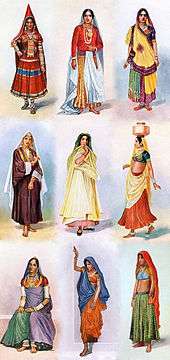
Lehenga, Chaniya, or Ghagra[5] is a form of skirt which is long, embroidered and pleated. It is worn as the bottom portion of a Gagra choli. It is secured at the waist and leaves the lower back and midriff bare.[6] The ancient version of skirt or Ghagri evolved from Bhairnivasani, which in turn evolved from the Antariya when stitched on one side became tabular and was worn gathered together at the waist, and held by a girdle. This was one of the earliest forms of a clumsily stitched skirt. It was worn using drawstring or nada. The ghagri was a narrow skirt six feet long the same length as original antariya. This style can still be seen worn by Jain nuns in India.
Until the early 20th century, women irrespective of class largely wore gagras which reached down to ankles, especially in Hindi belt. This was largely due to jeweled toes showed marital status of women as both married and unmarried women observed Ghoonghat. Gagras were made out of two to three layers of coarse khadi fabric which created large flared look and remained largely undecorated but were decorated with gota and badla embroidery on special occasions. Most commonly used dyes were Indigo, Lac and Haldi. This style can still be seen in rural areas of Haryana, Uttar Pradesh & Madhya Pradesh particularly during folk festivals.
Ancient unstitched form of gagra has survived in folk theater costumes across India, particularly in Kathakali of Kerala, where layers of pleated khadi fabric are laid over a nada and tied around the waist creating layers of flared skirt. This reflects simplistic early style of unstitched gagras worn in ancient times.
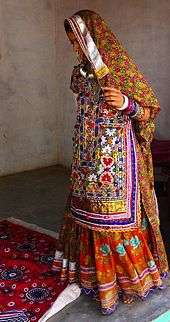
Dupatta
The Dupatta is a shawl or large scarf that is worn together with the lehenga and the choli. Until the early 21st century dupatta was the most decorative part of gagra choli, while rest of the garment was more simplistic, especially the gagra as everyday wear. Dupatta is worn in many regional styles across India. Most common style since early medieval times was to pleate the dupatta on the one end and tucking it into the front of the gagra and wrapping it across the waist and over the shoulder or head, similar to the way sari is worn. While women who worked in the farms tucked both ends of dupatta into their choli.
It is worn as a symbol of modesty. There is no single way of wearing the dupatta, and as time evolves and fashion modernizes, the style of the dupatta has also evolved.
Fabrics
The lehengas are made of a number of fabrics such as Silk, Cotton, Khadi,[7] Georgette, Crape, Net, Satin, Brocade and Chiffon.[8] Even though designers have successfully used the various kinds of fabrics for making the lehenga, silk is still the most preferred fabric.
Decorative stitching
Apart from the fabric, decorative stitching patterns also play a role. Lehengas come with a wide variety of decoration and embroidery work like Gota, Phulkari, Shisha, Chikankari, Zari, Zardozi, Nakshi, Kundan, etc.[9] For festivals like Navratri, the ethnic Shisha embroidery is popular with a bit of patchwork. For formal wear and weddings, the embroidery is heavier in pearls, silk, sequins and zari.[7]
Kutch embroidery is an evolving expression of the craft and textile traditions of the Rabaris, a nomadic tribe in Gujarat. Kutch embroidery is unique in the sense that a net is woven on a cloth using thread.The net is then filled in using the same thread by intricate interlocking stitches. The patterns are usually built around geometric shapes.This embroidery follows its own traditional design logic and juxtaposition of colours and motifs.[10] The Rohanas tribals of Kutch specialise in skirt work. The Sodhas use a geometric style for their embroidery. The Garacia Jats are experts in tiny embroidery on the yoke, which intermingles with red, orange, blue and green threads. The Dhanetah Jats love embroidering broad pear-shaped mirrors using orange, black, yellow and red in chain stitch.[7]
Festive attire
The lehenga choli is the favourite female apparel worn during festivals, weddings or special events in India. This is due to traditions as well as of the fact that it is available in a number of fabrics with many different decorative choices.[11] Traditionally the sari and the lehenga choli are the most popular garments for the bride in India.[12] But it is a common bridal attire mostly in North India and is also the traditional wear of Garba festival in Gujarat.[13]
Ritu Kala - Significance in rite of passage
In southern India coming of age ceremony or rites of passage (Langa Voni Telugu: లంగా వోని, Pattu Pavadai Tamil: பட்டு பாவாடை, Langa Davani Kannada: ಲಂಗ ದ್ವನಿ) is celebrated when a girl reaches puberty. She wears Langa Voni during the first part of the ceremony and then she is given her first Sari, which she wears during the second half of the ceremony. This marks her transition into womanhood.
The tradition of presenting Langa Voni begins with the girl's first naming ceremony called Namakaran and her first rice feeding ceremony called Annaprashana. She receives her last one at her coming of age ceremony. Langa Voni is traditional clothing for unmarried girls in southern India.
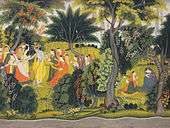
Luanchari
Luanchari (Hindi:लौन्चारी) is a full-dress garment. The Luanchari is made up of two parts, the upper part is called choli it is made of the same fabric as of the lehanga but it is not uncommon to find the two pieces of the garment in different colours. The choli is stitched to the lehanga, to make one-piece luanchari. That one finds commonly worn by the women in Pahari miniatures, and is quite similar to lehanga.[14] It takes well over 16 to 21 yards to make a complete Luanchari.[15] It is traditional garment worn by Gaddis of Himachal Pradesh.[14]
Images
-
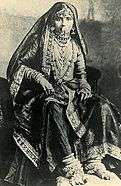
Women in Gagra Choli
-
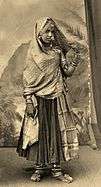
Women in Gagra Choli
-

Himachal women in Luanchari
-

Bride in Ghagra Choli or Lehenga.
-
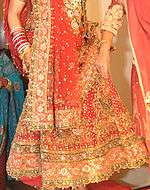
Bridal Gagra with Gota Embroidery
-
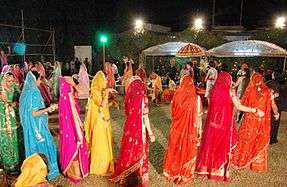
Women dancing in Gagra Choli during Wedding in Delhi.
-

Plaque depicting ancient form of long choli and gagra worn during Gupta Empire
-

Gagra with Badla embroidery from 1800's.
-
Punjabi Ghagra
-

Priyanka Chopra in a modern Ghagra-choli
See also
References
- ↑ Rajasthan (district Gazetteers) - Rajsamand
- ↑ People of India: Rajasthan, Part 1 - K. S. Singh
- ↑ Gujarat, Volume 1 - Rash Bihari Lal, Anthropological Survey of India
- ↑ Punjabi Sabhiachaar barey by Jit Singh Joshi Waris Shah Foundation
- ↑ Fashions from India - Tom Tierney
- ↑ Social Science a Textbook in History for Class IX as per New Syllabus - FK Publications
- 1 2 3 Dhanwanti Keshavrao (October 8, 2005). "Dressed for dandiya". The Tribune. Retrieved 12 April 2012.
- ↑ Types of Indian Lehengas - nrigujarati.co.in
- ↑ The latest fashion trends in saree collection - newsbycompany.com
- ↑ K.JESHI (Jul 19, 2004). "Exquisite embroidery". The Hindu. Chennai, India. Retrieved 12 April 2012.
- ↑ Lehengas-An Elegant Wear - Pooja Lapasia
- ↑ Fashionable wedding attire - The Hindu
- ↑ India - R.I.C. Publications
- 1 2 Textiles, Costumes, and Ornaments of the Western Himalaya - Omacanda Hāṇḍā - Google Books. Books.google.co.in. Retrieved 2013-10-25.
- ↑ Life Style, Indian Tribes: Locational Practice - Shiva Tosh Das - Google Books. Books.google.co.in. Retrieved 2013-10-25.
